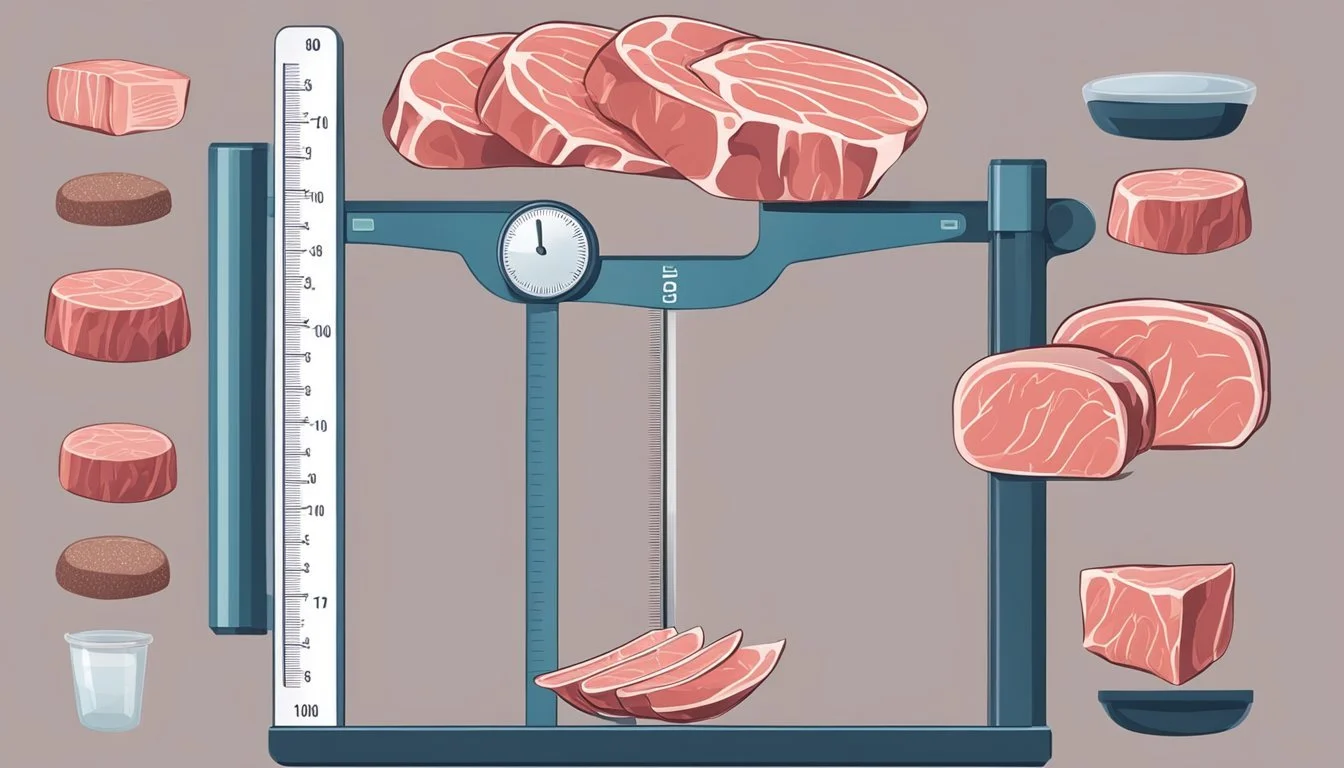How Much Lean Meat Should You Eat Per Day?
Understanding Daily Protein Intake
The consumption of lean meats is considered an important component of a balanced diet. These meats are a valuable source of high-quality protein, essential for muscle repair and growth, and serve as an important supplier of iron and zinc. Recommendations regarding the intake of meat vary according to dietary guidelines, but a shared emphasis is on selecting lean options that can contribute positively to one's health without contributing excessive saturated fat and cholesterol.
While lean meats can be beneficial, it's important to consider quantity in the context of an overall healthy eating plan. Nutrition experts suggest that a maximum of 455 grams of cooked lean red meat per week, which amounts to about 65 grams per day if eaten daily, can help meet mineral requirements without overindulgence. For those who prefer to consume meat less frequently, a larger portion of around 130 grams every other day is suggested.
In alignment with guidelines for healthy eating, the focus should also be on the type of meat consumed. Selections such as skinless poultry and lean cuts of beef, which contain less fat and saturated fat, are preferred. Integrating these meats into a diet with a diverse array of foods, including ample vegetables, fruits, and whole grains, forms the foundation of a nutritious and balanced approach to eating.
Understanding Lean Meat
Incorporating lean meat into one's diet is vital for getting sufficient protein while minimizing intake of saturated fat and cholesterol, which are linked to increased heart disease risk. This section delves into what lean meat is, its health benefits, and how it compares to processed meats.
Definition of Lean Meat
Lean meat is characterized by its low fat content, especially saturated fat, making it a preferable choice for healthy eating. The United States Department of Agriculture (USDA) assigns the "lean" label to cuts of meat with less than:
10 grams total fat
4.5 grams saturated fat
95 milligrams cholesterol
per 3.5-ounce serving. Extra-lean meat goes further, with less than:
5 grams total fat
2 grams saturated fat
per serving. Types of lean meat include skinless poultry such as chicken and turkey, beef cuts like tenderloin and sirloin, pork tenderloin (What wine goes well with pork tenderloin?), and most fish.
Health Benefits
Lean meats are an excellent source of protein, which is essential for muscle repair and growth. Additionally, they provide key vitamins and minerals such as iron, zinc, and vitamin B12 without excessive saturated fat, thus helping to maintain a healthy weight and reduce the risk of heart disease. Regularly consuming lean meats can also lead to lower blood cholesterol levels, contributing to overall heart health.
Lean Meats vs. Processed Meats
Lean meats differ significantly from processed meats in terms of health impacts and nutritional value. Processed meats—like sausages, ham, and bacon—are often high in saturated fat, cholesterol, and sodium. They typically contain additives and preservatives including nitrates, which are associated with an increased risk of certain diseases. In contrast, lean meats contain less of these substances and are generally not processed, meaning they retain more of their natural nutrients and are lower in calories.
Choosing a salad with grilled chicken over a fast-food hamburger, for example, provides protein without an overload of saturated fat and sodium, aligning with guidelines for heart-healthy diets and maintaining a balanced approach to nutrition.
Recommended Lean Meat Intake
Understanding the appropriate intake of lean meat can significantly contribute to a balanced diet, fulfilling protein requirements and providing vital nutrients without excessive calories. The American Heart Association provides guidelines to help ensure meat consumption is in line with a healthy diet.
General Guidelines
Lean meat is a valuable source of high-quality protein and essential nutrients such as iron and zinc. It is defined by its low fat content, particularly saturated fat, which should be less than 10% of daily calorie intake. A general recommendation is to limit lean red meat (What wine goes well with red meat?) to a maximum of 455 grams cooked (about 600-700 grams raw) per week. This translates to roughly:
One small portion (65 grams cooked/100 grams raw) daily, or
One larger portion (130 grams cooked/200 grans raw) every other day.
Gender-Specific Recommendations
Men and women have different nutritional needs, influenced by energy expenditure and muscle mass. For adult men and women, the following serving sizes are suggested:
Women: Aim for approximately 2 to 3 servings of lean meat or its equivalent per day. One serving equals 65 grams cooked (100 grams raw).
Men: Require larger portions and should aim for about 3 servings daily. A single serving is approximately 85 grams cooked (125 grams raw).
Children's portions will vary according to age and growth needs but should be smaller than adult portions.
Intake for Athletes and Active Individuals
Athletes and individuals with a high level of physical activity have increased protein requirements to support muscle repair and energy needs.
Active Adults: May require additional protein, equating to about 1.2 to 2.0 grams of protein per kilogram of body weight per day.
Athletes: Can consume approximately 112 to 150 grams of cooked lean meat daily, depending on the intensity of their training and their overall diet.
It is important for active individuals to distribute their protein intake evenly throughout the day and especially after exercise sessions to optimize muscle protein synthesis.
Optimal Sources of Lean Protein
Choosing the right sources of lean protein is crucial for maintaining a balanced diet. They offer essential nutrients while helping to manage weight and cholesterol levels.
Types of Lean Meats
Lean meats are a staple for those seeking high-quality proteins without excess fat. Chicken and turkey are excellent choices – skinless options are particularly low in fat. When it comes to red meats like beef and pork, it is best to opt for the loin cuts such as tenderloin or sirloin, which are generally leaner. A serving size, being typically three ounces of cooked meat, is roughly the size of a deck of cards.
Seafood as a Protein Source
Seafood encompasses a wide array of lean proteins, rich in omega-3 fatty acids, which are beneficial for heart health. Fish such as salmon and sardines are particularly notable for their high omega-3 content. For those looking for the leanest options, white-fleshed fish present an excellent choice, with a typical serving providing less than 3 grams of fat and about 20-25 grams of protein.
Vegetarian Alternatives
Plant sources of protein often double as sources of other nutrients while being lower in calories and fats. Tofu, made from soy, is a versatile ingredient that packs about 44 grams of protein per cup. Legumes like beans, lentils, and chickpeas are not only rich in protein but also fiber, iron, and folate. Veggie burgers made from these legumes provide a convenient and satisfying meat-free protein option.
Healthy Cooking Methods
When it comes to consuming lean meats, how they are cooked can make a substantial difference in nutrition. These methods focus on retaining the meats' nutritional value while minimizing added fats.
Techniques to Reduce Fat
When preparing meats, one can optimize for lower fat content by trimming visible fat and opting for skinless poultry. Instead, using techniques such as:
Baking or roasting in the oven.
Broiling under direct heat.
Grilling over charcoal or gas.
Ensures that excess fat drips away from the meat during the cooking process.
Preparing Meats Without Added Fats
Cooking methods that do not require adding extra fats include:
Poaching meats in water or broth.
Steaming, which works exceptionally well for fish like salmon.
Stir-frying using a minimal amount of oil, ideally a spray or a brush.
Substituting high-calorie ingredients in recipes with broths, citrus juices, or wine can enhance flavors while keeping the fat content in check.
Alternatives to Meat-Based Dishes
Plant-based alternatives can offer the same satisfaction as meat-based dishes when prepared thoughtfully, incorporating ingredients such as:
Vegetables, fruits, whole grains, seeds, and peas.
Using beans or lentils as the protein base in recipes.
Creating meatless meals several times a week using a variety of grains and vegetables for a well-rounded diet.
Managing Meat Consumption in a Balanced Diet
In a balanced diet, lean meat plays a significant role as a source of essential nutrients; however, managing its consumption helps maintain the diet's overall healthfulness. The inclusion of a variety of other foods such as vegetables, fruits, and whole grains, alongside the monitoring of saturated fat intake, is essential for fostering a holistic approach to eating.
Incorporating Variety in Your Diet
To ensure a nutritionally diverse intake, incorporating a range of foods is key. Lean meats provide a valuable source of protein, but legumes, nuts, and dairy products also offer quality proteins and other nutrients. A balanced plate might feature a modest portion of meat with larger proportions of vegetables, whole grains, and a side of salad to enhance satiety and nutrient diversity.
Understanding the Role of Meat in Cultural Eating Patterns
Cultural norms significantly influence meat consumption. While some cultures regard eating meat, including dishes like burgers and cheese-laden foods, as central to dining, it's important to put emphasis on moderation and consider the incorporation of meat alternatives such as legumes and nuts. Acknowledging cultural habits allows for a respectful yet health-conscious approach to dietary recommendations.
Monitoring Saturated Fat Intake
A core concern in meat consumption is its contribution to saturated fat intake, which is linked to coronary heart disease. The Dietary Guidelines recommend limiting saturated fat to less than 10% of daily calories. Choosing lean cuts of meat and pairing them with vegetables and whole grains instead of refined foods can help manage the risk of heart disease. Regularly opting for salad or vegetables instead of fries with a burger, or adding legumes to a dish in place of some meat, is a manageable strategy for reducing saturated fat intake.
Nutrients to Complement Lean Meat Intake
When including lean meat in one's diet, it is essential to consider other nutrients that support overall health and enhance the benefits of protein-rich foods.
Importance of Iron and Zinc
Lean meats are not only high in protein but also rich in iron and zinc, minerals crucial for vital bodily functions. Iron is key for oxygen transportation in the blood, while zinc supports the immune system and wound healing. To maximize absorption, lean meat should be eaten alongside vitamin C-rich foods such as bell peppers and broccoli.
Iron: Important for red blood cell production and prevention of anemia.
Zinc: Plays a role in immune function, protein synthesis, and DNA formation.
Beneficial Fats and Omega-3s
While lean meats contain less fat, incorporating beneficial fats, especially omega-3 fatty acids, is important for heart health. Omega-3s, found in fish, nuts, and seeds, reduce inflammation and are linked to a lower risk of heart diseases.
Omega-3 fatty acids: Support cardiovascular health and reduce inflammation.
Examples of omega-3 rich foods include:
Flaxseeds
Chia seeds
Walnuts
Salmon
Vitamins and Minerals in a Protein-Rich Diet
A diet rich in lean meats should also include a variety of vitamins and minerals to ensure a balanced nutrient intake. Vitamins B, especially B12, are abundant in lean meats and play a key role in nervous system function and energy production. Including a mix of vegetables, legumes, and nuts helps cover the spectrum of minerals and maintain nutrient balance.
Vitamin B12: Essential for neurological function and red blood cell formation.
Minerals: A balanced diet contains a variety of minerals that work synergistically with proteins.
Special Considerations
When planning your diet, it's crucial to consider various factors that may affect your choice and quantity of lean meat consumption. These range from personal health concerns to broader ethical implications and the potential impact of meats on chronic diseases.
Red Meat Allergies and Intolerances
Individuals may experience allergies or intolerances to red meat, such as beef, lamb, and pork. This can result from a sugar molecule found in these meats known as alpha-gal, to which some people develop a sensitivity. Manifestations may include hives, gastrointestinal discomfort, and in severe cases, anaphylaxis. It's essential for those affected to adjust their meat intake accordingly and seek meat alternatives or opt for grass-fed meat, as some studies suggest it may cause fewer allergic reactions.
Ethical and Sustainable Meat Consumption
Consumers are increasingly evaluating the ethical and sustainable practices underlying their food choices. Opting for grass-fed and sustainably farmed meat supports animal welfare and reduces environmental degradation. These products generally have a higher upfront cost but are considered more ethical choices. The focus is not only on quantity but also on the quality and origin of the meat consumed.
Link Between Meat Consumption and Chronic Diseases
Research has shown a link between high consumption of red meat and an increased risk of heart disease, stroke, and raised cholesterol levels. It's advisable for those concerned with heart health to limit their red meat intake and select leaner cuts, which can be part of a heart-healthy diet. The relation to chronic diseases is not exclusive to red meat, as processed meats from pork and other sources also contribute to these risks. Balancing meat consumption with plant-based proteins can mitigate these risks.
By factoring in allergies and intolerances, making ethical and sustainable choices, and understanding the health implications, individuals can make informed decisions about their lean meat consumption.







